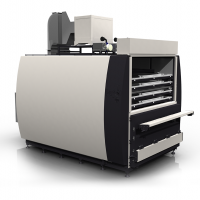Today’s consumers expect glass to be a perfect, invisible product. Glass has imperfections, however, like all man-made products. And often, that is fine. Problems arise when an issue is noticed – and we are no longer able to look past it.
The most common quality issues that arise in tempered glass are roller waves, glass distortion, bad anisotropy and white haze. In this post, we want to focus on white haze and ways to control it.
How do we see white haze on glass?
White haze can be described as very small scratches, which appear on the glass surface as vague, foggy areas or repetitive stripes. The phenomenon is also called “ghosting.”
One of the most common signs of white haze is a long blemish in the center of the glass. The effect can also appear near the edges, on the corners – or even all over the glass.
There are many reasons why white haze can occur, and all of them can be solved by eliminating the root cause. A systematic approach is key here.
Glass preprocessing as one major source of white haze
In our experience, up to 80% of white haze issues are caused during the processes prior to tempering. Only around 20% appear as a result of tempering itself.
Most white haze is nothing more than glass dust generated by the edge grinding process. The dust should be washed off the preprocessed glass in the washing machine. However, if the water wasn’t cleaned properly beforehand and starts recirculating, it creates a fine dust layer on the glass. During tempering, this layer fuses onto the glass and appears as white haze.
The solution is to wash and rinse the water tanks of the glass washer often and properly – if necessary, more than once per day.
Know where the tin side is
Another measure that helps reduce the severity of possible white haze before tempering is to check which side of the glass has the tin side. When float glass is manufactured, one of its sides touches the molten tin, which then leaves an invisible tin coating on the glass. The other side is known as the air side. Checking which side is which is easy with a short-wave ultraviolet light, which reveals the slight fluorescence the tin coating side obtains.
Keep in mind that white haze appears more severely on the air side. So, run the glass tin side against the rollers whenever possible.
Mechanical issues causing white haze
The most common reason for white haze in the tempering process itself is residue on the furnace rollers. This residue then causes tiny scratches on the glass surface.
If this is the case, examine the roller surfaces. Are they rough, cracked or brittle? Are there any solid particles on the surfaces? If so, take corrective action accordingly.
It’s important to ensure there is no chance of dust flying into the furnace. General cleanliness of the production environment is key. In addition, take care to inspect the insulation. Furnace doors should be in perfect operating condition to prevent any particles from entering the machine.
The leveling of the rollers is also important. If they are not properly adjusted, white haze can be caused by mechanical pressure that is too strong between the glass and the rollers.
Last but not least, check out the drive system. Is the drive speed consistent? Are the belts in good condition? Make sure the roller bearing works well.
Process parameters impacting the formation of white haze
If the root cause is in the process parameters, you will notice that the defect is not always repeated. It may be only a certain glass thickness or type that ends up with white haze marks.
If you’re dealing with non-optimized tempering parameters, you should be able to fix the issue by adjusting the settings to run the glass as flat as possible. One way of doing this is by decreasing the temperature of the bottom section and/or increasing the top convection. Note! Excessive top convection creates a different glass quality issue.
Safety is not affected, but still…
Even though white haze on tempered glass often looks like a quality issue, the safety and durability of such glass are not affected. If it breaks, the glass will still behave like normal safety glass.
No defects are ever welcome – especially those that are clearly visible. Issues like white haze have a direct impact on glass processors’ profit. No wonder we all strive to keep it to an absolute minimum.
But can you know if a particular type of white haze is acceptable by the industry? Actually, now you do!




























